
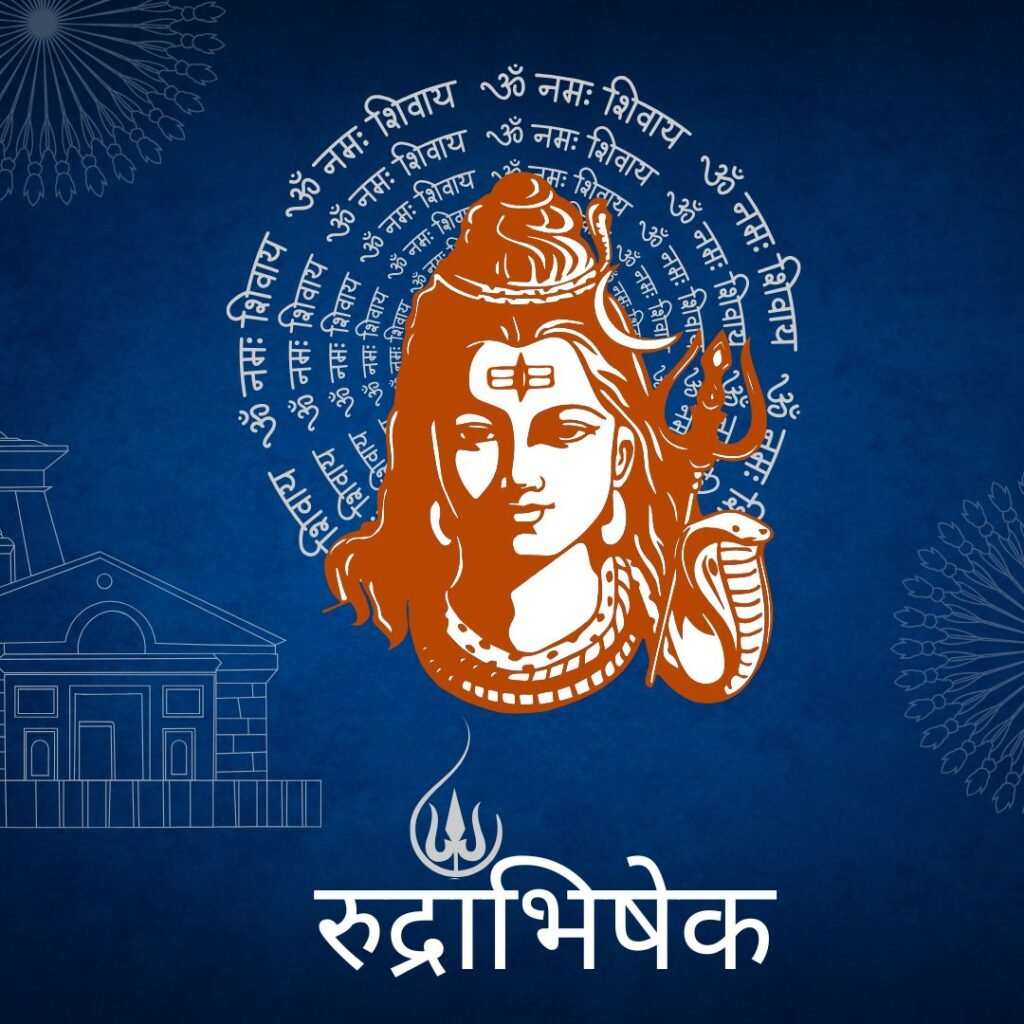
RUDRABHISHEK
Rudrabhishek (Rudra Abhishek) is the sacred “bath” of Lord Shiva’s Linga, performed with holy offerings—milk, water, honey, ghee—and accompanied by chanting powerful mantras like “Om Namo Bhagavate Rudraya”, invoking spiritual purification and divine grace.
1
Clean yourself and the puja area. Set the Shiva Linga on a clean surface facing east or north.
2
Light a diya and incense sticks to purify the space.
3
Take a Sankalp (resolve) with water in hand and mentally state your name and purpose.
4
Invoke Lord Shiva by offering flowers, rice, and chanting “Om Namah Shivaya.”
5
Perform Panchamrit Abhishek with milk, curd, honey, ghee, and sugar water, after Gangajal.
6
Decorate the Linga with sandalwood paste, flowers, and fresh Bilva leaves.
7
Chant mantras like Rudrashtadhyayi, Maha Mrityunjaya Mantra, Gayatri Mantra.
8
Offer fruits, sweets, and do aarti with a ghee diya to everyone.
9
Pray and conclude the puja with devotion. Distribute prasad.
Rudrabhishek Historical & Holy Origins
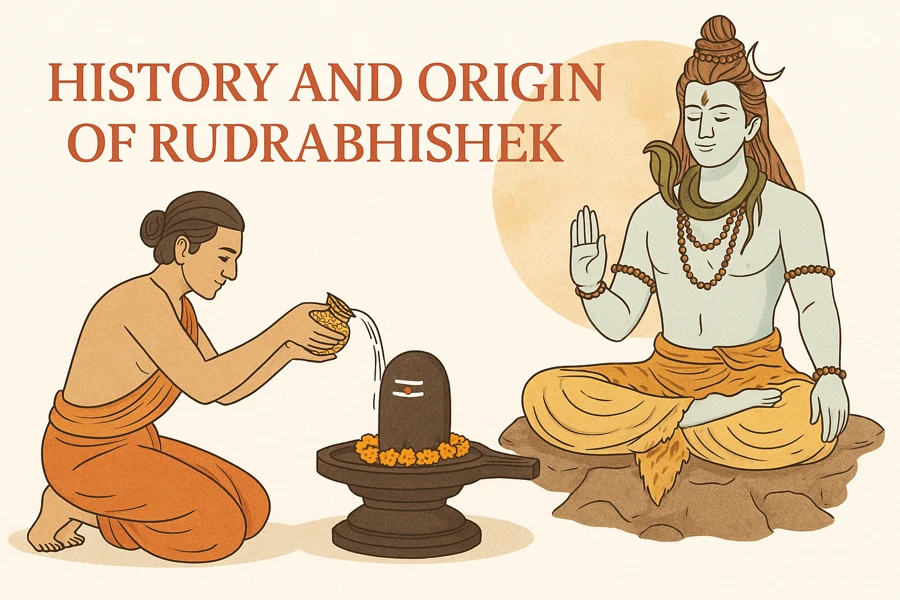
Rudrabhishek finds its roots in the ancient Vedic texts, especially the Yajurveda, where Lord Shiva is worshipped as Rudra, the fierce protector and transformer. This sacred ritual has been performed for thousands of years to honor Shiva’s cosmic power. According to legends, Lord Rama performed Rudrabhishek at Rameswaram to seek blessings before his battle with Ravana. The Pandavas also performed it during their exile to gain strength and divine favor. Over time, this puja became a key part of spiritual practice in temples and homes, symbolizing the eternal bond between devotees and Lord Shiva.
Rudrabhishek Mantra (रुद्राभिषेक मंत्र)
॥ महारुद्राभिषेक पूजा मंत्र ॥
ॐ नम: शम्भवाय च मयोभवाय च नम: शंकराय च
मयस्कराय च नम: शिवाय च शिवतराय च ॥
ईशानः सर्वविद्यानामीश्व रः सर्वभूतानां ब्रह्माधिपतिर्ब्रह्मणोऽधिपति
ब्रह्मा शिवो मे अस्तु सदाशिवोय् ॥
तत्पुरुषाय विद्महे महादेवाय धीमहि। तन्नो रुद्रः प्रचोदयात्॥
अघोरेभ्योथघोरेभ्यो घोरघोरतरेभ्यः सर्वेभ्यः सर्व सर्वेभ्यो नमस्ते अस्तु रुद्ररुपेभ्यः ॥
वामदेवाय नमो ज्येष्ठारय नमः श्रेष्ठारय नमो
रुद्राय नमः कालाय नम: कलविकरणाय नमो बलविकरणाय नमः
बलाय नमो बलप्रमथनाथाय नमः सर्वभूतदमनाय नमो मनोन्मनाय नमः ॥
सद्योजातं प्रपद्यामि सद्योजाताय वै नमो नमः ।
भवे भवे नाति भवे भवस्व मां भवोद्भवाय नमः ॥
नम: सायं नम: प्रातर्नमो रात्र्या नमो दिवा ।
भवाय च शर्वाय चाभाभ्यामकरं नम: ॥
यस्य नि:श्र्वसितं वेदा यो वेदेभ्योsखिलं जगत् ।
निर्ममे तमहं वन्दे विद्यातीर्थ महेश्वरम् ॥
त्र्यम्बकं यजामहे सुगन्धिं पुष्टिबर्धनम् उर्वारूकमिव बन्धनान् मृत्योर्मुक्षीय मा मृतात् ॥
सर्वो वै रुद्रास्तस्मै रुद्राय नमो अस्तु । पुरुषो वै रुद्र: सन्महो नमो नम: ॥
विश्वा भूतं भुवनं चित्रं बहुधा जातं जायामानं च यत् । सर्वो ह्येष रुद्रस्तस्मै रुद्राय नमो अस्तु ॥
Rudra Suktam (रूद्र सूक्तं) For Blessing Of Lord Shiva
॥ अथ श्री रूद्र-सूक्तम् ॥
नमस्ते रुद्र मन्यवऽ उतो तऽ इषवे नमः।
बाहुभ्याम् उत ते नमः॥1॥
या ते रुद्र शिवा तनूर-घोरा ऽपाप-काशिनी।
तया नस्तन्वा शन्तमया गिरिशंताभि चाकशीहि ॥2॥
यामिषुं गिरिशंत हस्ते बिभर्ष्यस्तवे ।
शिवां गिरित्र तां कुरु मा हिन्सीः पुरुषं जगत् ॥3॥
शिवेन वचसा त्वा गिरिशाच्छा वदामसि ।
यथा नः सर्वमिज् जगद-यक्ष्मम् सुमनाऽ असत् ॥4॥
अध्य वोचद-धिवक्ता प्रथमो दैव्यो भिषक् ।
अहींश्च सर्वान जम्भयन्त् सर्वांश्च यातु-धान्यो ऽधराचीः परा सुव ॥5॥
असौ यस्ताम्रोऽ अरुणऽ उत बभ्रुः सुमंगलः।
ये चैनम् रुद्राऽ अभितो दिक्षु श्रिताः सहस्रशो ऽवैषाम् हेड ऽईमहे ॥6॥
असौ यो ऽवसर्पति नीलग्रीवो विलोहितः।
उतैनं गोपाऽ अदृश्रन्न् दृश्रन्नु-दहारयः स दृष्टो मृडयाति नः ॥7॥
नमोऽस्तु नीलग्रीवाय सहस्राक्षाय मीढुषे।
अथो येऽ अस्य सत्वानो ऽहं तेभ्यो ऽकरम् नमः ॥8॥
प्रमुंच धन्वनः त्वम् उभयोर आरत्न्योर ज्याम्।
याश्च ते हस्तऽ इषवः परा ता भगवो वप ॥9॥
विज्यं धनुः कपर्द्दिनो विशल्यो बाणवान्ऽ उत।
अनेशन्नस्य याऽ इषवऽ आभुरस्य निषंगधिः॥10॥
या ते हेतिर मीढुष्टम हस्ते बभूव ते धनुः ।
तया अस्मान् विश्वतः त्वम् अयक्ष्मया परि भुज ॥11॥
परि ते धन्वनो हेतिर अस्मान् वृणक्तु विश्वतः।
अथो यऽ इषुधिः तवारेऽ अस्मन् नि-धेहि तम् ॥12॥
अवतत्य धनुष्ट्वम् सहस्राक्ष शतेषुधे।
निशीर्य्य शल्यानां मुखा शिवो नः सुमना भव ॥13॥
नमस्तऽ आयुधाय अनातताय धृष्णवे।
उभाभ्याम् उत ते नमो बाहुभ्यां तव धन्वने ॥14॥
मा नो महान्तम् उत मा नोऽ अर्भकं मा नऽ उक्षन्तम् उत मा नऽ उक्षितम्।
मा नो वधीः पितरं मोत मातरं मा नः प्रियास् तन्वो रूद्र रीरिषः॥15॥
मा नस्तोके तनये मा नऽ आयुषि मा नो गोषु मा नोऽ अश्वेषु रीरिषः।
मा नो वीरान् रूद्र भामिनो वधिर हविष्मन्तः सदमित् त्वा हवामहे॥16॥
Rudrabhishek Samagri (Item List for Puja)
Here is the list of items required for the Rudrabhishek Samagri:
Shiva Linga
Gangajal & clean water
Milk, curd, honey, ghee, sugar (Panchamrit)
Bel Patra (Bilva leaves)
Flowers (esp. white, Datura, Aak)
Sandalwood paste
Incense sticks & camphor
Diya (oil lamp)
Fruits, sweets, dry fruits (prasad)
Akshat (rice)
Rudraksha mala for chanting
Small copper or brass pot for abhishek
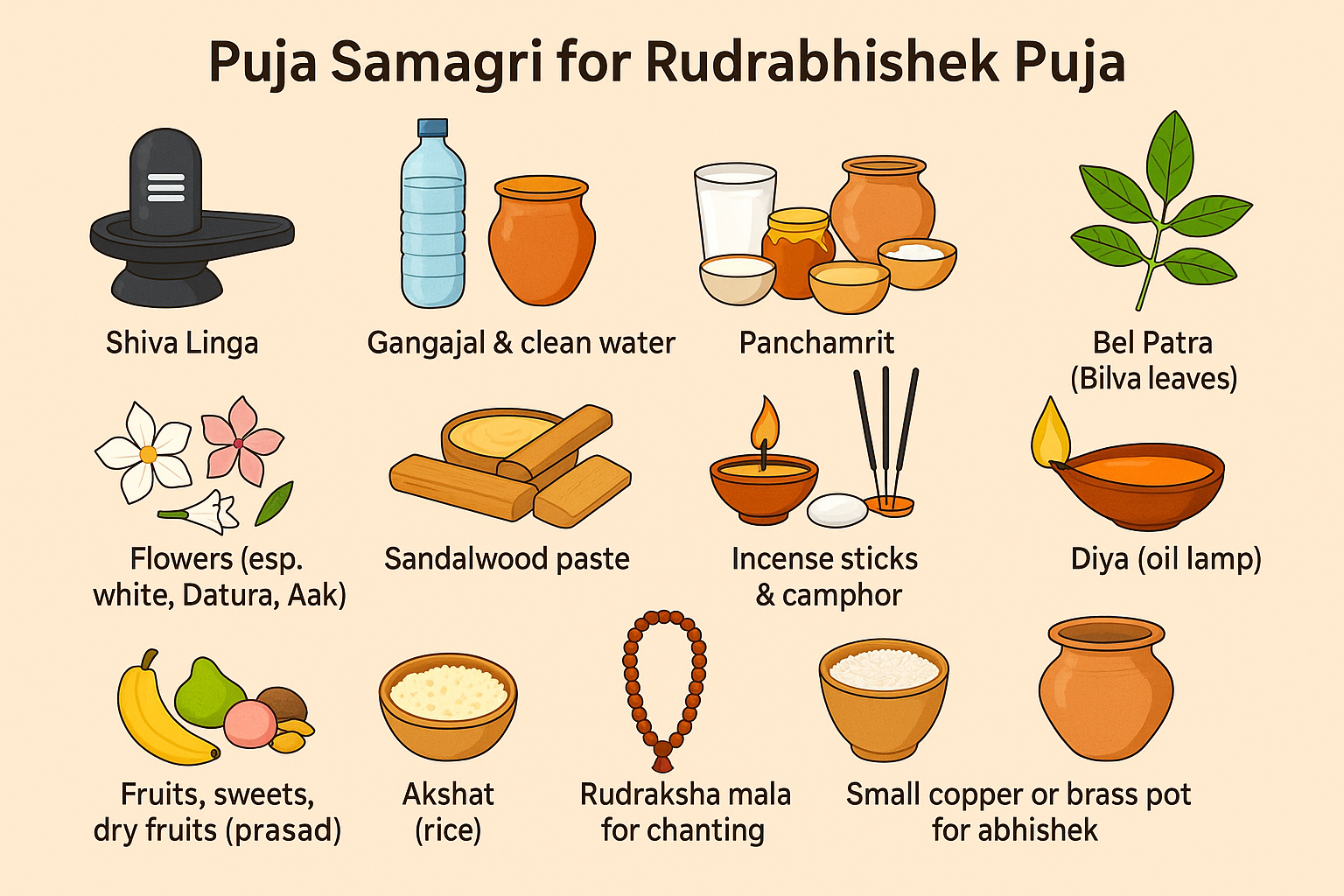
Rudrabhishek Types
Types of Rudrabhishek: Mainly two types — Laghu Rudrabhishek (short form) and Maha Rudrabhishek (elaborate form with full Rudram chanting).
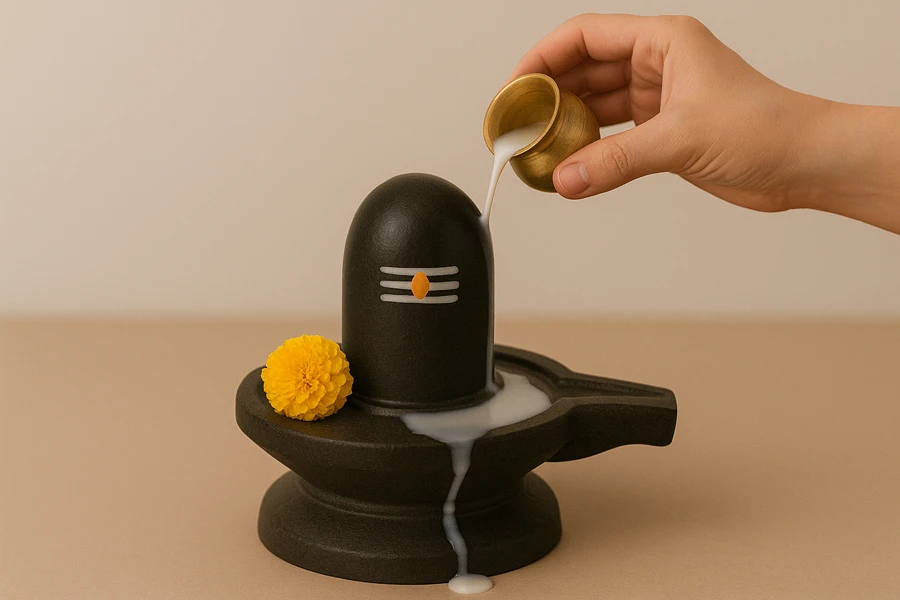
Laghu Rudrabhishek
A simplified version of the ritual with basic offerings and chanting of selected Rudra mantras. Ideal for regular worship or beginners.
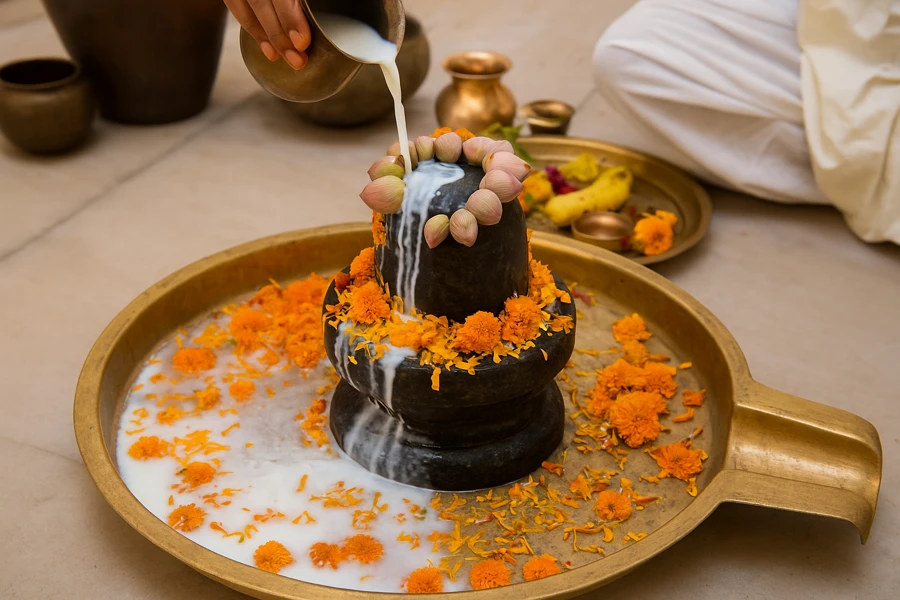
Maha Rudrabhishek
A more elaborate ritual that includes full recitation of the Rudri (Rudrashtadhyayi), additional prayers, and a Havan (fire ritual) for intensified spiritual benefits.
When You Can Perform Rudrabhishek?
Rudrabhishek can be performed on any day with devotion, but it holds special significance on certain occasions:
Shravan Month
Especially Mondays during this holy month are highly auspicious for Lord Shiva worship.
Mahashivratri
The most sacred night dedicated to Lord Shiva, ideal for performing Rudrabhishek.
Mondays (Somvar)
Any Monday is considered sacred for Shiva devotees.
Pradosh Vrat Days
Evening hours during this vrat are favorable.
Rudrabhishek Puja Vidhi
Place the Shivling on a clean and sacred spot. Ideally, it should be placed over a base made of Bilva (Bel) leaves.
Ensure that your clothes, the puja area, and all puja items are clean and pure.
Start by pouring plain water over the Shivling while chanting:
“Om Gangaya Cha Yamunay Chaiva Godavari Saraswati,
Narmade Sindhu Kaveri Jalesmin Sannidhim Kuru.”
After water, perform the abhishek using milk, curd, honey, ghee, and flowers. With each item, continue chanting “Om Namah Shivaya” with devotion.

Frequently Asked Questions
What is Rudrabhishek done for?
Rudrabhishek is performed to please Lord Shiva and seek His blessings for peace, protection, prosperity, and removal of negativity. It is believed to bring spiritual growth, calm planetary doshas, and fulfill heartfelt wishes.
What are the 11 items for Rudrabhishekam?
The commonly used 11 items are:
Water (Gangajal)
Milk
Curd
Honey
Ghee
Sugar or Mishri
Sandalwood paste
Bilva (Bel) leaves
Flowers (especially white)
Fruits and dry fruits
Incense sticks or camphor
How to perform Rudrabhishek at home?
Place a Shivling on a clean, sacred spot. Light a diya and incense. Offer water while chanting sacred mantras. Then perform Abhishek with Panchamrit (milk, curd, honey, ghee, and sugar), followed by Gangajal. Offer Bilva leaves, flowers, and prasad. Chant “Om Namah Shivaya” or Maha Mrityunjaya Mantra, and end with aarti and prayers.
What are the rules for Rudrabhishek puja?
Always begin with a clean body and pure mind.
Use fresh and sattvik (pure) items only.
Offer Bilva leaves in odd numbers.
Do not use Tulsi or spoiled items.
Chant mantras sincerely during abhishek.
Mondays and Shravan month are highly auspicious.
Can females do Rudrabhishek?
Yes, women can perform Rudrabhishek. In Sanatana Dharma, devotion is above all. Some traditions advise avoiding puja during menstrual days, but practices may vary by family or region.
